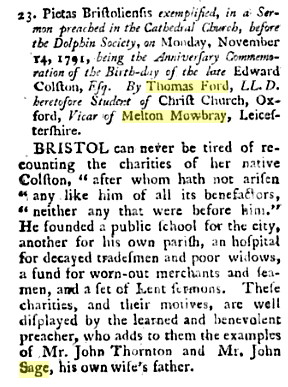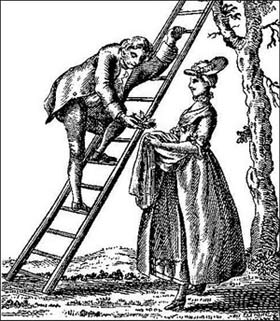While transcribing Wivenhoe marriages 1754-1812, I found several marriages for people called Sage, and a serial witness called Edward Sage. I noticed that one of these marriages was of Mary Ann Sage to Philip Havens esqr. of East Donyland – Philip is related to me by marriage when Isabella Lingwood and Shadrach Seaman’s daughter married William Rawdon Havens. In fact, John Warren (1802-1875), my 3 x great-grandfather, was Philip Haven’s woodman in 1866 (this particular Philip being, presumably, son or grandson of Philip and Mary Ann). So it piqued my interest and I decided to look into the Sage family.
There is an excellent resource called Colchester People, which I have recommended in another article, and always will. It’s the details of hundreds, if not thousands, of people who lived in Colchester in the 18th century – the “middling sort”, who worked hard and left wills and other documents which mean we can add substance to their lives from the bald dates and names in parish registers. It is the archive, collated by Shania D’Cruze into three volumes, of a lifetime’s research in various Essex archives by John Bensusan-Butt. It is a splendid resource for anyone with Colchester family. You can buy a paperback (Amazon links at the end of the page) or download as an ebook from Lulu.
I found an entry in Colchester People for Edward Sage, butcher, which told me that he was married to Ann Carrington in Wivenhoe in 1776 – and this is perfectly correct, as I found a marriage in Wivenhoe for this couple. Ann was from Tollesbury, the daughter of William Carrington, a butcher (I would imagine he’s something to do with the farmer Carringtons on the Tendring peninsular). The entry explains that Edward moved on from Wivenhoe to Colchester, and died a wealthy man in 1816, having £20,000 invested in a business with Irish linen factor Mr. Richard Jennings; his widow died in Liverpool in 1835. Very interesting stuff!
So I looked about and found his PCC will, but as soon as I started to read it, I was confused: it said that Edward’s wife was called Sarah, not Ann. I thought that perhaps Ann had died and Edward remarried, so I made a note of Edward’s children in the will.[1]There are a lot of other people, besides, mentioned in the will – Emily and Edward Hobbs, two children that ended up in Edward’s care; his sister-in-law Alicia Rawdon; Elizabeth Rawdon, … Continue reading It mentions a son called John, then six daughters: Harriet, Alicia (wife of James Barker), Matilda (wife of James Rawdon), Elizabeth Grellet (presumably the wife of someone called Grellet), Emma (wife of Thomas Langston) and finally Mary Ann (wife of Philip Havens). I compared all this to the Wivenhoe baptism register and found most of the corresponding marriages for the daughters. Mary Ann married in 1796, and Emma and Elizabeth both married in 1802 (Elizabeth to Frederick Grellet). Over in East Donyland, I found Alicia’s marriage to James Barker. Philip Havens witnesses all of these marriages (except, of course, for his own), and someone called William Rawdon witnesses both marriages in 1802.
But there were other Sage marriages in the Wivenhoe register: Ann Sage, who married John Sarjant Lay in 1803, and William Carrington Sage, who married Mary Neal in 1807. Why weren’t they mentioned in their father’s will? Had they both died by 1816?
Knowing that even the moderately well-to-do are fairly likely to appear in newspapers, I delved about for the Sages. I found a death in 1813 for Edward, son of Edward Sage of Cheapside (the PCC will mentions property in London, so this seemed plausible); the death notice of Edward senior from 1816, which says he died at his house in Colchester and was of Cheapside (tying up again with Edward who died in 1813); marriage notices for Edward’s daughters, and a death notice for Mrs. Sage, widow of the late Mr. Edward Sage of Wivenhoe, butcher, who died at Braintree in 1831. But in 1835, the Chelmsford Chronicle had a death notice for Mrs. Sage, widow of Edward Sage esqr, late of Colchester, who died near Liverpool at Brunswick House: “the mansion of her son-in-law, James Rawdon esq.” And that ties in with Matilda being the wife of James Rawdon in the 1816 will.
Well, those Mrs. Sages, both widows of Edward, can’t both be correct – they can’t both be widows of the same man (unless he was a bigamist, of course!). I went through Wivenhoe’s baptisms and the names of the children of Edward and Ann Sage did not match up with those in the 1816 will. What was going on? Then I started to realise…. There was not one Edward Sage, as the entry in Colchester People said, but two.
I searched Essex Record Office’s catalogue and found a will for Edward Sage of Wivenhoe, butcher, in 1811. It is fairly short, and mentions his wife Ann, then two sons (Edward Sage and William Carrington Sage) and three daughters (Ann, Elizabeth and Mary). The will was written in 1802, and it says Edward died in Wivenhoe on 25th December 1810. There is a burial in Wivenhoe’s register for Edward Sage, aged 69, who was buried on 30th December 1810. Meanwhile, another Edward Sage, aged 71, was buried in Colchester at St. Mary-at-the-Walls on 9th December 1816. There are photographs of his box-tomb on Find a Grave. And he’s the chap who left the PCC will and had £20,000 invested with Richard Jennings’ Irish linen business.
It is, admittedly, confusing to start with – it seems that at some point in the late 1700s, both Edward Sages were living in Wivenhoe. One of them (husband of Ann Carrington), raised his family in Wivenhoe, but it seems that the other Edward (husband of Sarah Rawdon), married in Halifax in 1771 and their children’s baptisms appear in London non-conformist registers (certainly some of their circle were Unitarians) – this has perhaps contributed to the confusion and made it seem as if there was only one Edward Sage because most of the Essex records are for one family. If you search for “Edward Sage” on ERO’s catalogue, you’ll find several mentions of a man by that name having dealings with various pieces of property in Wivenhoe – to confuse things further, I think that, again, it could be both Edwards involved at different times.
The mention of Edward’s sister in the 1816 PCC will – Elizabeth, wife of Reverend Dr. Thomas Ford – was very helpful, as it led me to a piece in The Gentleman’s Magazine, February 1792, where Mr. John Sage is mentioned in a piece about the Rev. Ford as “his own wife’s father.”

So I searched for John Sage, and I found a PCC will from 1787, when he died in Stanmore, Middlesex. It named five sons (Edward, Isaac, John, Joseph and William) and four daughters (Elizabeth, Margaret, Mary and Sarah). This man would appear to be the father of the Edward Sage (1745-1816), married to Sarah Rawdon, who was buried in Colchester.
I haven’t got further back than this yet. I find myself wondering if it’s not a coincidence that two men, both called Edward Sage, contemporaries (one lived 1741-1810, the other 1745-1816), chose to live in the same place – and I wonder if they were in fact cousins. It’s certainly possible….
[Edit 27th October 2020: I wrote this several years ago. That note in the Gentleman’s Magazine is referring to Edward Colston, whose statue met a watery end a few months ago during the Black Lives Matters protests. I’ve only just realised he’d been mentioned on my website, but I didn’t know who he was until his statue went for a swim as I don’t know a huge amount about Bristol. My interest was in John Sage anyway. But it’s interesting to note that Colston is presented as an extraordinary benefactor in this short piece, when his wealth was derived from horrendous exploitation and cruelty.]Footnotes
| ↑1 | There are a lot of other people, besides, mentioned in the will – Emily and Edward Hobbs, two children that ended up in Edward’s care; his sister-in-law Alicia Rawdon; Elizabeth Rawdon, widow of his late partner and brother-in-law William Rawdon; Reverend Dr. Thomas Ford and his wife – Edward’s sister – Elizabeth. |
|---|

